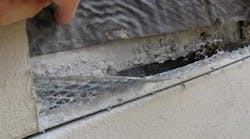No facility manager wants to encounter water intrusion and damage. When it occurs, it can result in buckets of uncertainty, expense, and frustration. The correction process can be complicated by business interruption, the competing interests of the parties involved, and lack of knowledge about the cause.
Diagnosing problems of water intrusion – and proving their existence to others – are often hindered by failing to maintain detailed records of weather conditions, locations of leaks and damage, and prior repairs. Hoping for a quick resolution, an owner may select ill-conceived repairs without understanding the risks. Such repairs can mask causes, make diagnosis more difficult, and lead to greater damage.
In most cases, the most effective means of preserving the function, integrity, and value of a building is a long-term repair based on a comprehensive analysis. The following cases of facade failure illustrate how a misguided repair can result in higher final costs than a correct repair with higher initial costs.
Failure 1
A 10-Year-Old, Stucco-Clad High-Rise
A high-rise residential building in the southeastern U.S. showed signs of water intrusion shortly after its construction. The building facade was constructed of Portland cement plaster (stucco) veneer over metal lath applied to concrete masonry units (CMU) or exterior gypsum sheathing over steel studs. The stucco showed excessive cracking over both substrates during and after construction.
Project specifications and local building code required the stucco to be applied over an internal drainage system, which included a felt-paper, weather-resistant barrier drained to weeps and flashings at the base of the walls and above wall openings, windows, and doors. A wall system with internal drainage behind the exterior cladding has the ability to evacuate incidental water that penetrates cracks and minor openings in the skin , making it more reliable at resisting moisture penetration than a system without an internal drainage system.
The contractor returned to the project and applied sealants over cracks in the stucco under the terms of the warranty. However, no effort was made to identify the root causes or possible defects. Initially, the sealants reduced the water infiltration.
Several years after the remedial sealant application, water intrusion increased to severe levels as the sealants began to deteriorate. Furthermore, stucco applied over the CMU had become loose and partially detached. The owner undertook a detailed evaluation, including water testing and destructive openings. The investigation revealed the presence of widespread and systemic defects in the internal drainage system, including open gaps in the felt-paper, weather-resistant barrier. These hidden defects were the root cause of the leaks.
The investigation found other concealed problems, such as deficient lath application that led to cracking, lath fasteners that were not embedded in the CMU wall, and total lack of flashings to direct water out of the facade. The investigation also revealed damage from long-term water intrusion, including rusting lath fasteners and degraded gypsum exterior sheathing.
The sealant repair masked the leaks by reducing water entry into the building. However, these repairs did not address the root causes or protect the building from further damage. Ultimately, all stucco and most of the exterior gypsum sheathing, as well as substantial amounts of water-damaged interior finishes, had to be replaced.
The misguided sealant repair, which was represented as fulfilling the warranty obligation, made it more difficult to pursue the parties responsible for the defective construction. Such repairs can mask symptoms beyond the statute of limitations. It is critical for the owner to understand the root causes and the costs to repair them, as well as the risks of alternate or superficial repairs.
Failure 2
A 20-Year-Old, Barrier EIFS-Clad Hotel
A 20-year-old, 300-unit hotel building was undergoing due diligence by a prospective buyer. The building’s exterior walls were covered with barrier-type EIFS (exterior insulation and finish system) consisting of foam insulation adhered to paper-faced gypsum sheathing and covered with a thin, stucco-like lamina. This system is commonly referred to as a surface-sealed facade system because it relies entirely on the facade sealants, the water tightness of windows and other components penetrating the facade, and the integrity of the lamina.
As discussed above, a system lacking internal drainage and flashings is less reliable. The presence of moisture-susceptible materials – such as the paper-faced gypsum sheathing, steel-stud framing, and interior-wallboard materials behind the facade – make it prone to degradation from water penetration.
During the due-diligence process, the prospective buyer’s enclosure consultant learned that the facade had suffered from water intrusion early in its life and that the facade sealants had been replaced. The new sealant reportedly reduced, but did not eliminate, leaks that eventually affected most rooms. Several years before placing the building on the market, the building owner had applied a waterproof coating to the facade and again replaced the sealants. However, there was no documented attempt to determine how the water was entering the wall or to assess the condition of the paper-faced gypsum sheathing or steel-stud framing inside the wall.
The enclosure consultant found the new coating and sealant to be in good condition. However, review of the interiors revealed peeling wallpaper and other water damage. Openings into the interior walls revealed wet materials, indicating that despite the recent resealing and recoating, water intrusion continued. Openings made in the facade revealed advanced corrosion to steel-stud framing and deterioration of the paper-faced gypsum sheathing to the extent that the adhesive attachment of the EIFS insulation to the sheathing was severely compromised. The evaluation also showed that leaks through the window system and window frames were the likely culprit. Earlier repairs had not discovered the window leaks.
The solution required repair of framing and replacement of the entire facade system, windows, and large amounts of interior finishes. The costs were estimated to be far greater than it would have been if the leaks had been remedied at an early stage. The projected repair and replacement costs became a factor in negotiating the building’s purchase price.
Failure 3
A New Office Building
A high-rise office building in the Midwest had substantial rain-driven leaks through its facade. The owner and property manager began to document the leaks immediately, even before the interior space had been built out and occupied.
The exterior walls consisted of a glass and aluminum curtainwall placed into three-story punched openings within a brick-veneer cavity wall. The curtainwall design was based on a two-tiered approach to prevent water infiltration – first, by shedding rainwater from the surface by a system of seals and gaskets between the glass and metal frames, and second, by providing an internal, wept drainage system around and behind the glass to drain any water that breached the exterior surface. Similarly, the brick cavity wall design sheds most rainwater at the brick surface. Felt-paper, weather-resistive barrier and flashings form the internal drainage system to evacuate water that penetrates the brick.
Shortly after systemic leak patterns were documented, the owner engaged a consultant to determine the causes, provide recommendations to correct them, and evaluate repairs proposed by the contractor. The investigation found misapplication of seals within the internal drainage system and failure to construct the wall flashings around the curtainwall in a continuous and watertight manner. At this point, the consultant recommended repairing the facade to meet the design intent, which would require removing glass from the curtainwall in order to install internal seals and reconstruct flashing.
The contractor refused to repair the building in accordance with these recommendations, instead proposing to apply external sealants over exterior curtainwall joints and between the curtainwalls and the brick. The contractor also proposed limited repairs to some flashing elements.
This situation presented the owner with a dilemma – either allow the original contractor to move forward with his proposed repair, or hire another contractor to repair the building in accordance with the original design. Among the factors that the owner needed to consider:
- The repairs proposed by the contractor did not maintain the original design intent or remedy the deficiencies in the internal drainage systems.
- The cost to restore the internal drainage systems to the original design requirements was much more than the value of the contractor’s proposed repairs. Moreover, the restoration would disrupt tenants by requiring access to all interior space.
- The cost of the recommended restoration would be at the owner’s expense until such time as the costs could be recovered through litigation.
- The contractor’s lesser repair might adversely affect the building’s resale value if water intrusion continued.
Ultimately, the owner rejected the original contractor’s proposal and retained another contractor to implement the consultant’s recommended repairs. This action succeeded in correcting the leaks.
Throughout the repair process, the owner documented deficiencies in the original construction. The repair costs were later awarded to the owner from the contractor in a jury trial.
Four Lessons Learned
- Document conditions – where water is seen, how much, and under what conditions (rainfall, wind speed and direction, dates and times). Documentation helps to identify the causes and provide evidence for possible litigation. Maintain repair records and invoices to help establish an owner’s diligence in mitigating damages.
- Establish the causes of leakage as early as possible in order to minimize damage and develop repair solutions that address the causes. In most cases, diagnosis requires probe openings and water-intrusion tests. Early intervention and repair are critical to preserve wall components and finishes.
- Evaluate repairs that maintain the original design intent – assuming the design is sound. Understand the intent and be wary of other repairs, such as application of sealants to facades that have internal drainage and flashings. These approaches may hide problems until a warranty or statute of limitations has expired.
- Consider lesser solutions only with a full understanding of their limitations, including effects on building value, future leaks, repairs, increased maintenance, and business interruption.
Eric K. Olson, P.E., is a senior project manager at Simpson Gumpertz & Heger Inc. and a member of the firm’s building technology group. He is experienced in the investigation of building enclosure systems, including facades, roofing, and below-grade waterproofing, and in rehabilitation design, including preparation of design details and specifications. He can be contacted at [email protected].


